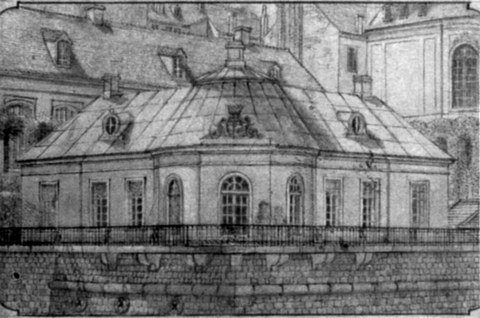19th Century
Table of contents
1828 – 1865
1828

View of the garden pavilion on Brühlsche Terrasse, the modest home of the Technische Bildungsanstalt in Dresden
1st May: The Technical School is founded in Dresden and the Royal Saxon Commerce Deputation takes over the administration. Wilhelm Gotthelf Lohrmann (1796-1840), who did great scientific service as Inspector of the Saxon Cameral Survey, is the director. For the time being, the domicile of the institute is located very modestly in the Garden Pavilion on Brühlsche Terrasse and in a vault of the Kuffenhaus on Zeughaus Square.

Design of the steam locomotive "Saxonia"
Outstanding teachers were convinced of the merits of working at the institute. Among them was Johann Andreas Schubert, designer of the first operational German steam locomotive "Saxonia."
1833
Due to the need for substantially more space, the Technical School is moved to the former armory at Jüdenhof.
1844/46

Building of the technical educational institution at Antonsplatz
A new building is erected at Anton Square, according to the plans of the architects Heine (1802-1880) and Arndt (1807-1889), to house the Technical School. Gottfried Semper (1803-1879) gives his expert opinion of the new building, in which he also writes about fundamental thoughts concerning architectural problems.
1851

Julius Ambrosius Hülsse
The establishment is renamed the Royal Polytechnical School. Under the initiative of the Director, Julius Ambrosius Hülsse (1812-1876), and with the close cooperation of the Royal Government Commissioner Dr. Weinlig, the "Upper Department" is divided into three sections that concentrate the students into three subject areas. The right exists to award certificates, based on "Matriculation Examinations," which allow the bearer to pursue a subject as a trade.
1865

Timetable for the upper department of the Technical College
Introduction of a new organizational plan. The "Lower Department" now sets up a "General Course" that all students must take. The "Sections" of the "Upper Department" are developed into four technical schools: Mechanical Technical School (A), Engineering School (B), Chemistry Technical School (C), and another school whose tasks consist of training future teachers of Mathematics, Natural Sciences, and Technology. The program duration at the technical schools is set at three years. The distinction is now made between "students" who take the "General Course" and students who attend the Technical School.
1871 – 1890
1871
In recognition of the high level of the education offered in technology and the natural sciences, the school is renamed the Royal Saxon Polytechnical College. The Polytechnical College takes on the character of a university. The administrative hierarchy is still organized autocratically, however. The technical schools are now referred to as departments. 281 students are enrolled at the college (more than 60 % belong to the Engineering Department).
1873

Gustav Anton Zeuner
Gustav Zeuner (1828-1907), internationally renowned Thermodynamics Engineer and Epistemologist, is appointed Director of the Polytechnical College. Besides taking classes in the Technological Sciences and Natural Sciences, studying the Arts and Linguistics is also highly regarded. Thus, the following subjects are taught in the "General Sciences Department": Economics, Jurisprudence, Philosophy, History, Art History, History of Literature, and Modern Languages.
1875

Main building of the Polytechnic Institute at Bismarckplatz
The representative main building of the Polytechnical College is completed near the main train station. With the founding of the Structural Engineering Department, the tradition of teaching architecture at the college is established.
1883
Introduction of the Diplom Examination in place of the Absolutorium. Students are now required to write a Master's thesis, as is the case at the Universities of Technology in Vienna, Graz, and Stuttgart.
1890

Official notice of 3 February 1890
The status of the Polytechnical College increases. It is now called the Royal Saxon Technical College. Ernst Hartig (1836-1900), professor of Mechanical Technology, becomes the first elected College Rector. 308 students, including 28 foreigners, are registered at the university.
